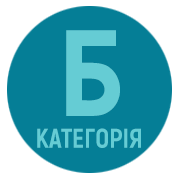ПРОБЛЕМИ ДИФЕРЕНЦІАЦІЇ ПОНЯТЬ «МОВА» ТА «ДІАЛЕКТ» В УКРАЇНСЬКОМУ СОЦІОЛІНГВІСТИЧНОМУ ПРОСТОРІ
DOI:
https://doi.org/10.25128/2304-1222.22.54.06Keywords:
sociolinguistics, dialect, literary language, literary text, lexical features, territorial principleAbstract
In the article, we try to define modern views on the differentiation of the concepts of “language” and “dialect”. The difference between the general literary language and dialects is illustrated on the basis of lexical and regional features. In the modern Ukrainian scientific discourse, the issue of distinguishing between language and dialect is understudied, which means that scientists have not yet agreed on the issues of their clear separation. Linguists have agreed that the general literary language is distinguished by stability, codification, and comprehensibility for all native speakers. Literary language is the language of education, science, media, etc. The dialect has certain features in the lexical, phonetic, grammatical system and is understandable only for a certain region or group of people. At the moment in Ukraine there are many dialects and each of them has its own peculiarities of formation, functioning, and existence in a certain territory. The greatest controversy in Ukrainian sociolinguistics is around the Transcarpathian dialect, which should be considered one of the dialects of the modern Ukrainian language. The article examines in detail the penetration of dialect speech into a literary work, which, on the one hand, implements local specifics into the author’s speech, and on the other hand, contributes to the entry of certain features of dialect speech into the all-Ukrainian speech fund. Ivan Franko drew the attention to the peculiarity of dialects to influence the literary text. The most interesting works on the use of dialects are the works of M. Kotsiubynskyi, Yu. Fedkovych, M. Pavlyk, D. Kharovyuk, M. Kozoris, D. Pavlychko, D. Bedzyk. The most interesting examples of the use of dialects in modern literary texts are the works of Volodymyr Lys, Yurii Vynnychuk, and Maria Matios. Among the interesting phenomena of the interaction of dialects and the literary language is Dilingualism – the use of the literary language and one of the dialectal forms of communication. Dialects enrich speech, expand the literary canon, and become a distinctive feature of an educated and linguistically gifted person.
References
Білоконенко Л.А. Соціолінгвістика : практикум. Кривий Ріг : КДПУ, 2020. 106с.
Гримашевич Г. І. Діалекти як джерело збереження культури та духовності українського народу. URL:http://nniif.org.ua/File/20ggidyd.pdf
Громик Ю. Поліські діалекти в сучасній художній літературі. Луцьк : Вежа-Друк, 2022. 304с.
Єрмоленко С. Я. Сучасна літературна мова і діалекти.// Рідне слово. Вип. 6. Київ : Наукова думка, 1972. С. 14–15.
Загальна психологія/ За загальною редакцією академіка С. Д. Максименка. Вінниця: Нова Книга, 2004.704 с.
Звонська Л. Л. Енциклопедичний словник класичних мов / Н. В. Корольова, О. В. Лазер-Паньків та ін./ За ред. Л. Л. Звонської. Київ : Київський університет, 2017. 552 с.
Іван Франко. Лїтературна мова і діялєкти. URL:https://zbruc.eu/node/68718.
Коваленко Б. Комплексне дослідження використання діалектів у мові української художньої літератури. Українська мова. 2011. № 1. С. 125–129.
Ковтун О. В. Діалектна лексика у сучасній українській прозі в аспекті перекладу. C.184–188.
Конституція України. URL:https://www.president.gov.ua/documents/constitution 11. Лагдан С. П. .Роль української мови у формуванні ціннісних орієнтацій студентської молоді. Формування загальнолюдських та патріотичних цінностей у студентської молоді. Дніпропетровськ: Дніпропетровський державний аграрно-економічний університет,. 2015. С. 219–224.
Левкова А. На кожне сільце — своє слівце.URL:https://www.verbum.com.ua/02/2021/the-languages-we-speak/each-place-its-word/
Масенко Л. Т. Літературна мова // Енциклопедія Сучасної України/ред.: І. М. Дзюба, А. І. Жуковський, М. Г. Железняк та ін.; НАН України, НТШ. Київ: Інститут енциклопедичних досліджень НАН України, 2016. Т. 17.
Масенко Л. Нариси з соціолінгвістики. Київ: Києво-Могилянcька академія, 2010. 242c.
Німчук В. Ще раз про «Русинський язик» і збереження діалектного середовища.// Українська мова. 2017. № 3. С. 15–24.
Різниця між мовою та діалектом у соціолінгвістиці. URL:https://uk.strephonsays.com/language-and-dialect-in-sociolinguistics-2337#menu-3
М.Рошко: руйнування міфів про закарпатський діалект. URL:https://varosh.com.ua/dumky/66494/.
Севрук В. Г. Діалекти українських циган. 2015 С.161–166. URL:http://elar.naiau.kiev.ua/bitstream/123456789/9220/1/%D0%A3%D0%9A%D0%A 0%D0%90%D0%87%D0%9D%D0%A1%D0%AC%D0%9A%D0%90%20%D0%9C%D0%9E%D0%92%D0%90_p195-200.pdf
Сердега Р. Л. Мова фольклору – діалект чи наддіалект // Лінгвістика. 2018. № 1 (38). С. 49–62.
Чому в українську мову повертається мода на діалекти? URL:https://www.ukrinform.ua/rubric-regions/2606464-comu-v-ukrainsku-movu-povertaetsa-moda-na-dialekti.html
Яворський Ю. Теоретичні засади вивчення діалектизмів у мові художньої літератури.// Лінгвостилістичні студії. Вип. 2. 2015.С. 230–236.
CentreNationaldeRessourcesTextuellesetLexicales.URL:https://www.cnrtl.fr/definition/idiome.
Listofdeclarationsmadewithrespecttotreaty No. 148. EuropeanCharterforRegionalorMinorityLanguages. URL:https://web.archive.org/web/20150918164438/http://www.conventions.coe.int/Treaty/Commun/ListeDeclarations.asp?NT=148&CM=1&DF=&CL=ENG&VL=1.










